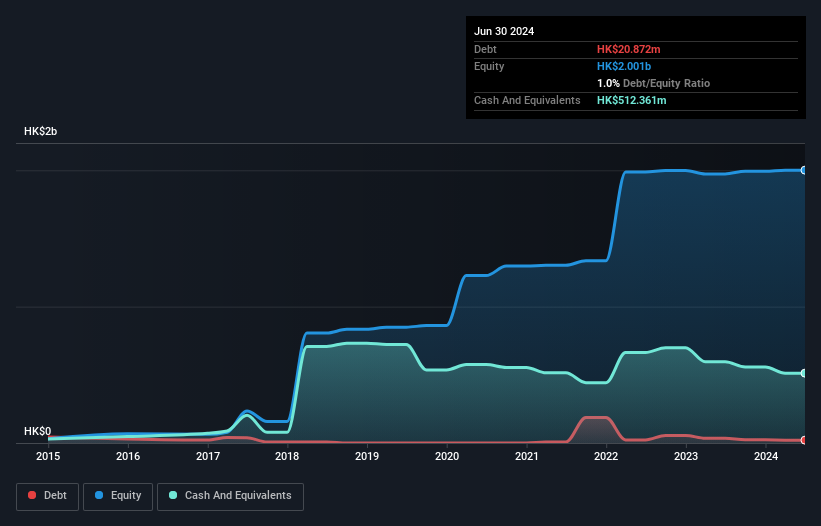Some say volatility, rather than debt, is the best way to think about risk as an investor, but Warren Buffett famously said that 'Volatility is far from synonymous with risk.' So it seems the smart money knows that debt - which is usually involved in bankruptcies - is a very important factor, when you assess how risky a company is. Importantly, C-MER Medical Holdings Limited (HKG:3309) does carry debt. But the more important question is: how much risk is that debt creating?
Why Does Debt Bring Risk?
Debt assists a business until the business has trouble paying it off, either with new capital or with free cash flow. If things get really bad, the lenders can take control of the business. However, a more frequent (but still costly) occurrence is where a company must issue shares at bargain-basement prices, permanently diluting shareholders, just to shore up its balance sheet. Of course, the upside of debt is that it often represents cheap capital, especially when it replaces dilution in a company with the ability to reinvest at high rates of return. The first step when considering a company's debt levels is to consider its cash and debt together.
How Much Debt Does C-MER Medical Holdings Carry?
As you can see below, C-MER Medical Holdings had HK$20.9m of debt at June 2024, down from HK$34.1m a year prior. However, its balance sheet shows it holds HK$512.4m in cash, so it actually has HK$491.5m net cash.

A Look At C-MER Medical Holdings' Liabilities
 We can see from the most recent balance sheet that C-MER Medical Holdings had liabilities of HK$362.3m falling due within a year, and liabilities of HK$411.1m due beyond that. Offsetting this, it had HK$512.4m in cash and HK$90.7m in receivables that were due within 12 months. So its liabilities outweigh the sum of its cash and (near-term) receivables by HK$170.3m.
We can see from the most recent balance sheet that C-MER Medical Holdings had liabilities of HK$362.3m falling due within a year, and liabilities of HK$411.1m due beyond that. Offsetting this, it had HK$512.4m in cash and HK$90.7m in receivables that were due within 12 months. So its liabilities outweigh the sum of its cash and (near-term) receivables by HK$170.3m.
Since publicly traded C-MER Medical Holdings shares are worth a total of HK$2.49b, it seems unlikely that this level of liabilities would be a major threat. However, we do think it is worth keeping an eye on its balance sheet strength, as it may change over time. While it does have liabilities worth noting, C-MER Medical Holdings also has more cash than debt, so we're pretty confident it can manage its debt safely.
Even more impressive was the fact that C-MER Medical Holdings grew its EBIT by 763% over twelve months. That boost will make it even easier to pay down debt going forward. There's no doubt that we learn most about debt from the balance sheet. But it is future earnings, more than anything, that will determine C-MER Medical Holdings's ability to maintain a healthy balance sheet going forward. So if you want to see what the professionals think, you might find this free report on analyst profit forecasts to be interesting.
But our final consideration is also important, because a company cannot pay debt with paper profits; it needs cold hard cash. While C-MER Medical Holdings has net cash on its balance sheet, it's still worth taking a look at its ability to convert earnings before interest and tax (EBIT) to free cash flow, to help us understand how quickly it is building (or eroding) that cash balance. Over the last three years, C-MER Medical Holdings actually produced more free cash flow than EBIT. That sort of strong cash conversion gets us as excited as the crowd when the beat drops at a Daft Punk concert.
Summing Up
While it is always sensible to look at a company's total liabilities, it is very reassuring that C-MER Medical Holdings has HK$491.5m in net cash. The cherry on top was that in converted 192% of that EBIT to free cash flow, bringing in HK$146m. So is C-MER Medical Holdings's debt a risk? It doesn't seem so to us. We'd be very excited to see if C-MER Medical Holdings insiders have been snapping up shares. If you are too, then click on this link right now to take a (free) peek at our list of reported insider transactions.
If, after all that, you're more interested in a fast growing company with a rock-solid balance sheet, then check out our list of net cash growth stocks without delay.
Have feedback on this article? Concerned about the content? Get in touch with us directly. Alternatively, email editorial-team (at) simplywallst.com.
This article by Simply Wall St is general in nature. We provide commentary based on historical data and analyst forecasts only using an unbiased methodology and our articles are not intended to be financial advice. It does not constitute a recommendation to buy or sell any stock, and does not take account of your objectives, or your financial situation. We aim to bring you long-term focused analysis driven by fundamental data. Note that our analysis may not factor in the latest price-sensitive company announcements or qualitative material. Simply Wall St has no position in any stocks mentioned.

